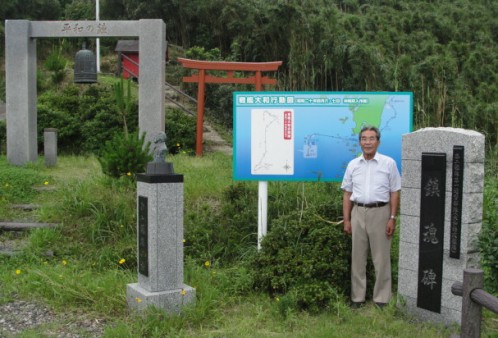Kuroshima Battleship Yamato Monument
Mishima Town, Kagoshima Prefecture
In the early morning of April 7, 1945, the battleship Yamato, the
light cruiser Yahagi, and eight destroyers went past the small island of
Kuroshima on their way to Okinawa to carry out a special (suicide) attack.
American aircraft sank Yamato, Yahagi, and four destroyers long
before they got close to Okinawa.
Takehiko Ena made a sortie from Kushira Naval Air Base on May 11, 1945, in a
three-man Type 97 Carrier Attack Bomber (Allied code name of Kate) as part of
the Kamikaze Special Attack Corps 3rd Seiki Squadron. When the plane had engine
problems, Ena and the other two crewman made a forced landing in the sea about one kilometer from
Kuroshima and swam to shore. They stayed on the small
island
for about two and half months until picked up by a small Army transport
submarine at the end of July.
In 2013, Takehiko Ena and Shigeyoshi Hidaka, Assembly Chairman for Ohsato
Ward of Mishima Town and author of a book of photographs of Kuroshima entitled
Shima no saigetsu (with English title of The days in the old home
island), erected a monument to remember the men
of Yamato, Yahagi, and escort destroyers who died in the special
attack mission on April 7, 1945. The front of the monument has the following inscription:
Monument for Repose of Souls of Second Fleet First Striking Force (Yamato
Special Attack Fleet)
The back of the monument has a plaque with the following explanation:
This is the island where early at daybreak on April 7, 1945, there was a
send-off for the Yamato Special Attack Fleet sortie. The 4,044
spirits of the dead became the cornerstone of peace. We dedicate this
monument here as we pray that they may rest in peace as they return riding
upon the south wind.
April 7, 2013
Persons who erected monument:
Takehiko Ena
Shigeyuki Hidaka

View of sea from Kuroshima Battleship Yamato Monument
The map to the left of the Battleship Yamato Monument shows the course
of the Yamato Special Attack Fleet along with the times that the ships
passed various locations. The map also indicates where the battleship Yamato,
light cruiser Yahagi, and destroyers Isokaze, Hamakaze,
Asashimo, and Kasumi sank on April 7, 1945.
The cleared area called Kuroshima Peace Park in the mountains near Ohsato Village where the
Battleship Yamato Monument stands also has a
Special Attack Peace Kannon erected in 2004, Peace Bell put up in 2006, Dōki
no Sakura (Cherry Blossoms of Same Class) monument, and torii gate. These
were made possible through contributions by Takehiko Ena, who after the war's
end continued for many years to provide support the island where he and his other two crew members had been
treated kindly when stranded there for two and half months near the end of the
war.

Yasuo Hidaka, who saw battleship Yamato pass by Kuroshima,
stands next to Kuroshima Battleship Yamato Monument
(June 20, 2015)
Lifelong Kuroshima resident Yasuo Hidaka was 11 years old when he saw the
battleship Yamato and the other ships of the Special Attack Fleet pass
nearby to the north of the small island as they were heading west.

View of mountains around Kuroshima's Ohsato Village
as seen from ferry leaving the island
The entrance to Kuroshima Peace Park has a metal plaque that
lists the men from Mishima (includes inhabitable islands of Kuroshima, Iōjima,
and Takeshima) in the Navy and Army who died in service during the Pacific War.
The list includes name, age, date of death, place of death, and home island for
the number of persons shown below:
20 from Kuroshima (includes 5 from Ohsato Village)
17 from Iōjima
9 from Takeshima
The plaque also lists information about the eight persons living
in Mishima who died from American air attacks during 1945.
|